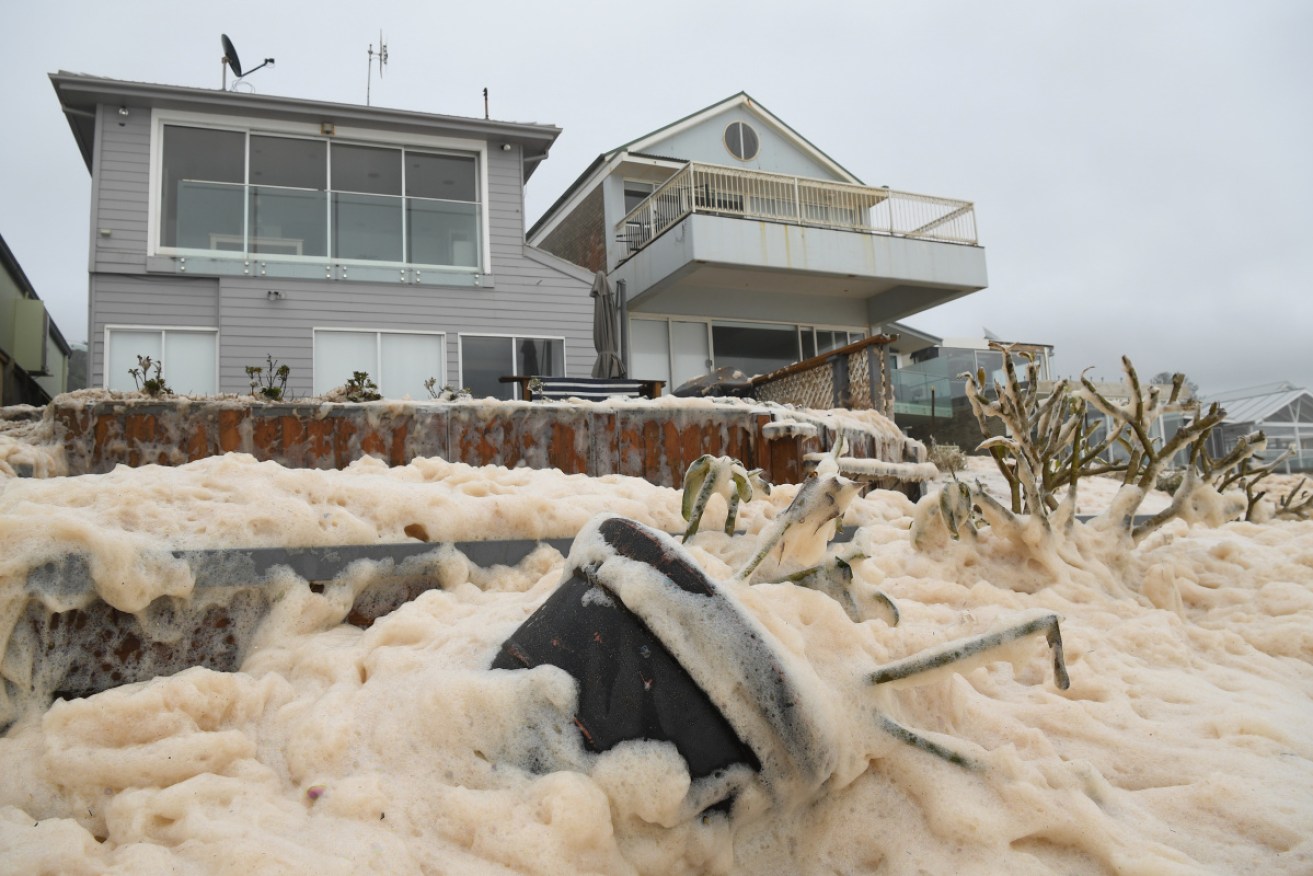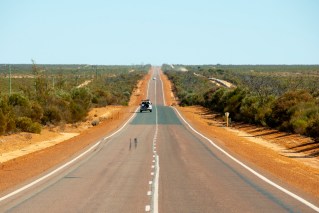‘Everywhere has been hit’: NSW counts costs of heaviest rain in three decades


Sea foam brought by high waves at beachfront Collaroy, on Sydney's northern beaches, on Monday. Photo: AAP
Flood warnings remain across NSW as torrential rainfall drenches greater Sydney and enormous waves smash into the coastline.
Rain continued to fall on Monday as the weather bureau warned cities and towns in NSW’s north-west, central and eastern areas, including Grafton, Armidale, Orange, Yass, Tamworth and Parkes, to prepare for severe thunderstorms and violent winds.
Dam levels have surged – up at least 20 per cent – after the weekend’s deluges, with Sydney getting its heaviest drenching in up to three decades.
Warragamba Dam, which supplies 80 per cent of Sydney’s water, could soon be at 70 per cent capacity. Days ago it was at 42 per cent.
Prospect Dam is more than 90 per cent full, while Woronora Dam to Sydney’s south is almost 60 per cent full, jumping 25 per cent.
The Bureau of Meteorology said the four-day rainstorm was Sydney’s heaviest since 1990, with 391.6 millimetres of rain across the region.
Some areas had copped up to 700 millimetres of rainfall since last Wednesday. Robertson in the Southern Highlands had 500 millimetres at the weekend alone.
Fire and Rescue NSW Deputy Commissioner Jeremy Fewtrell said emergency services had received a record number of triple-zero calls at the weekend as the storm raged.
“The number of calls we received in the peak period was almost double that that we were receiving at the worst of the bushfires,” Mr Fewtrell told Channel Seven.
“I think that gives an indication of the scale of the impact on such a broad part of the community of NSW … from the Tweed all the way down to the southern border with Victoria.”
Work is continuing to restore power to 16,500 customers. Yesterday’ storm interrupted power to 93,000 homes & businesses. While 76,500 customers are back on, there is many hours of work still needed to repair the 1,150 electrical hazards on the network. Please #StaySafe pic.twitter.com/wnCuPUOAi1
— Endeavour Energy (@endeavourenergy) February 10, 2020
The NSW SES said it had responded to about 10,000 calls for help – and took the unusual step of urging Sydney-siders to work from home on Monday if they could as the clean-up continued.
“Everywhere has been hit, it’s hard to pinpoint where it’s worst,” Matt Kirby from the SES said.
The Insurance Council of Australia has already declared the weekend a “catastrophe” with about 10,000 claims worth up to $45 million lodged on Sunday.
NSW Bureau of Meteorology acting manager Jane Golding said the weather and its impact across NSW imitated an east coast low.
“Over the last week we have seen some extraordinarily high rainfall all along the NSW coast,” she said.
The rain has also fallen in parts of drought-stricken NSW, including the north-west slopes, which have had up to 100 millimetres.
“That’s more rain than they have seen in quite a few years,” Ms Golding said.
The deluge also brought enough rain to finally extinguish the Gospers Mountain “mega-blaze” north-west of Sydney. The fire has burnt through more than 512,000 hectares since it was ignited by lightning strikes in a remote forested area on October 26.
“The Gospers Mountain fire … was officially set to ‘out’ this morning around 8.20am due to significant rainfall,” RFS spokesman James Morris said.
“A very damaging and destructible fire … a number of those communities obviously rejoicing with this rain that they’ve had now, and will now start that process of rebuilding.”
The downpour also extinguished the Erskine Creek and Currowan fires.
But while the rain was a delight for those fighting bushfires, it has been so severe that people have become trapped by rising rivers and floodwaters.
On Monday afternoon, NSW police called off a search for a man who was reported missing on Sunday after his car was swept off a causeway at Galston Gorge in Sydney’s north.
Police still want to hear from anyone who saw a silver Mercedes being swept away about 4.30pm on Sunday.
Just how much #rain has fallen over the past 24 hours in #NSW? Check out this animation to see where the rain fell, and for more detail go to our observations page: https://t.co/AhIgy7Jt6r pic.twitter.com/h4eGEPZGw1
— Bureau of Meteorology, New South Wales (@BOM_NSW) February 10, 2020
A further 200 people have been rescued after driving into floodwaters since the rain began on Friday.
A landslip in Leura has closed the Blue Mountains line west of Springwood. It will be closed for several days, Mr Collins said.
Four people were taken to hospital on Sunday afternoon after a tree fell on their car in the Sydney CBD, and a 16-year-old boy was treated for broken ribs after being trapped between debris in the Hunter’s Allyn River.
On Monday afternoon, more than 100,000 NSW residents remained without electricity.
They included more than 85,000 Ausgrid customers – primarily in northern Sydney and the NSW Central Coast – and 16,000 Endeavour Energy customers.
Power has been restored to 51,000 customers but 89,000 still remain without power, primarily in Sydney’s north, northern beaches, eastern suburbs, south and south west; the Central Coast & Newcastle. Power outages will continue for the next few days as we recover from the storm pic.twitter.com/Wj0h54Kd0N
— Ausgrid (@Ausgrid) February 10, 2020
Dozens of schools are closed across the state, and there are eight flood evacuation orders in place.
The Hawkesbury-Nepean, Georges, Parramatta and Colo Rivers have all overflowed and caused localised flooding, the ABC reported.
Evacuation orders were issued as the Georges River swelled to unprecedented levels.
On Sunday night, residents at Narrabeen Lagoon, on Sydney’s Northern Beaches, fled as their coastal properties came under threat. They have since been told it is safe to return.
The system that brought the torrential rain brought up to 150 millimetres of rain to the South Coast before it weakened and crossed into Victoria on Monday afternoon.
Earlier, the bureau had issued a severe weather warning for people in Victoria – especially East Gippsland – but has since cancelled it.
-with AAP








